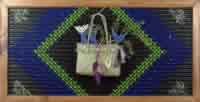Shirley Library Te Kete Wānanga o Ōraka 150 tukutuku panel
This panel was designed, created and constructed by the Shirley Library Team, as part of the Tukutuku project in 2009 to celebrate the 150th Anniversary of Christchurch City Libraries.
Shirley Mahinga Kai
- Landscape format
- Made from pegboard and dowels painted black
- Framed in rimu
- Materials used: wool, New Zealand flax, feathers, wood, paua, beads and sequins, iridescent thread, artificial pikopiko
- 1280 mmx 660 mm
Shirley Mahinga Kai symbolises the past, the present and the future. The blue and green arrows on the left point back to the past and the arrows on the right point towards the future. The panel emphasises the importance of moving towards the future while acknowledging the traditions and knowledge of the past.
The panel depicts the Shirley area as a Mahinga Kai (traditional food gathering area). In pre-European times the Horseshoe Lake area was a seasonal food gathering area and the region continues this tradition with market gardens and orchards, and more recently a large supermarket.
The focal point of the panel is the kete full of kai. Fish, birds and pikopiko are represented inside the kete whereas outside the kete are the tools that would have been traditionally used for hunting. There are feathers symbolising spears as well as a fish hook.
The blue arrow on the left depicts Horseshoe Lake, which the Shirley Library is named after (The library by the lagoon - Te Kete Wānanga o Ōraka). The blue arrow to the right depicts the Avon River which Horseshoe Lake flows in to. The green arrows on both sides signify the land and the abundance of food. The water feeds the land and the land nourishes the people. The tufts in the four corners represent the more modern orderly market gardens and the produce they yield.



 Find organisations, clubs, courses and more
Find organisations, clubs, courses and more
